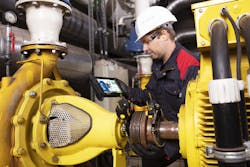5 Things To Ask Before Investing in a Laser Shaft Alignment System
Laser shaft alignment systems are crucial to properly aligning your machinery for peak performance and extended asset life. Their pinpoint accuracy makes them the correct choice for most industrial settings.
But all laser alignment systems are not equal. Some enable a maintenance team to complete jobs quickly and with high precision, while others require rework and sometimes guesswork that drive maintenance costs higher and compromise the result.
1. Does the system have single-laser technology?
Reasons for this question: A system with a dual-laser setup requires you to adjust two lasers and two sensors, which costs you time and effort and introduces more variables. Additionally, dual-laser systems cannot handle many gross misalignments because during the measurement rotation, the laser beam moves off the detector, and the measurement cannot be completed. Adaptive Alignment systems with single-laser technology have a "Freeze Frame Measurement" capability. This feature enables you to complete measurements when you're halted midway through a job because of the amount of misalignment, rather than have to restart. You eliminate guesswork and save time.
2. Does the system's user manual recommend a "rough alignment" or "pre-alignment"?
Reasons for this question: Systems that recommend—or require—a "rough alignment" cost more to operate because they demand more moves, which can be the most time-consuming part of any alignment job. The "as found" condition is lost, and technicians often have to progress through a move before they can even take a measurement.
3. Does the system provide visual quality-factor assessment feedback to the technician as the measurement is underway—or only after the measurement is finished?
Reasons for this question: Getting device feedback while doing a job is a better learning experience than afterward, and it saves time. It's essential to look for an Adaptive Alignment system that offers the innovation of real-time visual feedback. During a measurement, the user gets a quick color indicator for simple, intuitive feedback. Green indicates a decent quality measurement, while blue indicates an excellent quality measurement. Even the most inexperienced users can quickly learn how to take a quality measurement, thanks to this feature.
4. Can a technician send measurements instantly to colleagues elsewhere to consult on the next steps?
Reasons for this question: Two brains are often better than one. You may have an alignment specialist on your team, but he or she cannot get to every machine in every plant. But experts and consultants can evaluate and qualify measurement data remotely–if they have access to it –and render assistance from wherever they are.
Systems without cloud-based collaboration capabilities essentially cut the technician off from help, which is a significant factor behind variable alignment quality. Yes, an expert using the system may achieve better results than a less-experienced technician. But you are better served with a system with collaboration built-in to unlock overall team capacity. You can ensure that even the least experienced users get expert guidance and high-precision results by being able to work with a consultant standing by somewhere.
5. Does the system automatically handle uncoupled shafts without requiring manual efforts to position shafts at the correct relative angle?
Reasons for this question: For assets to perform at their peak, they must be installed with care. During installation, the alignment should be performed with uncoupled shafts to eliminate any machine train's residual forces. But working with uncoupled shafts is not something basic laser alignment systems can easily do. Technicians must resort to manual positioning to approximate the correct relative rotational angle.
In contrast, Adaptive Alignment systems, bolstered by Active Situational Intelligence (ASI) software, have uncoupled shaft awareness. This feature allows for uncoupled shafts to be in any rotational position—or freely rotating—as long as the single laser hits the lone sensor. The adaptive system determines the relative rotational angular positions and calculates the measurement points. With this capability, teams can achieve accurate results quickly.
These five questions pinpoint potential red flags when considering a new laser alignment system. When laser alignment began, adaptive capabilities did not exist. Today's advancements require asking these important questions.
Adaptive Alignment is the newest generation of laser shaft alignment, pioneered by Prüftechnik, a division of Fluke Reliability. The advanced capabilities were developed by listening to customers and focusing relentlessly on innovation and solutions to deliver the best possible results for their rotating machinery.
For more information, visit the Prüftechnik Adaptive Alignment webpage, where you can download a white paper outlining these capabilities.
